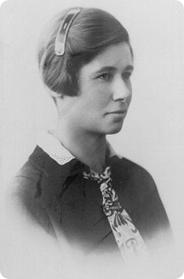 Engineer of the Week No.127: Constance Fligg Tipper (nee Elam) MA, DSc, FICST (16th February 1894 - 14th December 1995). For our very last EOTW for 2019, here is Constance Tipper, a very eminent metallurgist and a very rare example of an industry-standard test named after a woman. “Her work developed the new science of fracture mechanics, which is still used by engineers today to develop aeroplane wings that don't fall off and car axles that stay attached. So, today as the mechanical world around you doesn't fall apart, give thanks to Constance Tipper.” (http://www.engineerguy.com/comm/3731.htm) Constance was the daughter of a surgeon, William Henry Elam, and was educated at St Felix School, Southwold. She then went to Newnham College, Cambridge, gaining a third in part one of the natural sciences tripos in 1915. She first worked at the National Physical Laboratory’s metallurgy department, then at the Royal School of Mines, South Kensington, as an research assistant to Professor Harold Carpenter (1917). The Frecheville (1921–3) and the Royal Society Armourers and Brasiers (1924–9) eellowships enabled her to do research into the strength of single crystal aluminium. This was followed by research with Geoffrey Taylor, leading to the modern understanding of crystal plasticity. This period of work led to London University awarding her a DSc degree (1926). In 1928 Constance married George Howlett Tipper and moved to Newnham College, which had awarded her a research fellowship (1930–31). She remained there for over thirty years, during which time she occasionally lectured there and at the Chelsea Polytechnic. The university gave her testing facilities in the engineering department, and in 1947 the college elected her to be an associate fellow for three years.In 1949 the University made her a reader in mechanical engineering, which meant she was a full member of the faculty of engineering. Her war work led to her most influential research – on the deformation and fracture of iron and steel. This arose because theAdmiralty Ship Welding Committee wanted fractures in all-welded ships (eg the innovative Liberty ships) to be investigated. Constance Tipper found that their steel became dangerously brittle at low temperatures, and she developed her eponymous edge-notch test to predict whether the metal would behave in a brittle or ductile manner at service temperature. By 1948 she had authored or co-authored 12 academic papers and her wartime work led to her seminal book The Brittle Fracture Story (1962), the culmination of her career. She also enjoyed gardening, painting, and music. She died in 1995.
1 Comment
29/12/2019 11:31:19 am
Could you please email permission to reproduce your photo of Constance Tipper in a book I am writing for Elsevier?
Reply
Leave a Reply. |
- Home
- Electric Dreams
- All Electric House, Bristol
- Top 100 Women
- Engineer of the Week
- The Women
- Timeline
- WES History
- EAW
- Teatowels For Sale
- 50 Women in Engineering
- Museum Trails
- Waterloo Bridge
- History Links
- Blue Plaques
- Virtual Blue Plaques
- Career and Inspiration Links
- Contact
- Outreach
- Photo Gallery
- Bluestockings and Ladders
